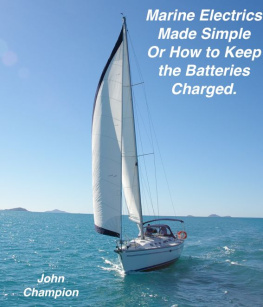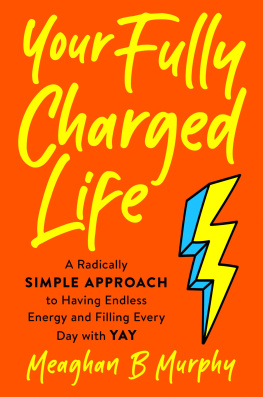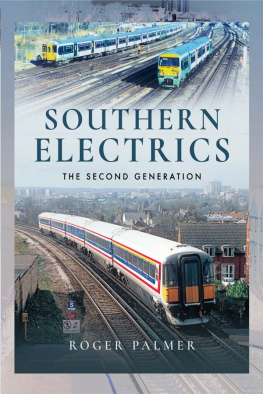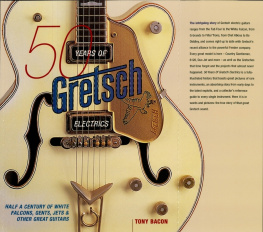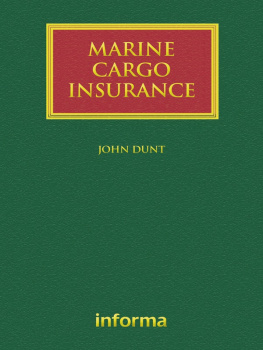Marine Electrics Made Simple
Or How to Keep the Batteries Charged.
John Champion
Smashwords Edition
Copyright 2012 John Champion
Chapter 1. How much energy do you need?
The wind is free and yachts use this energy to get around. Agood deal when you consider the amount of fuel necessary to get upthe coast or make a passage, never mind a circumnavigation.Additional energy however is still required to make a yachtcomfortable and convenient. Electricity is the ideal stuff for thisand we rely on it to run fridges, autopilots, lights, navigationequipment and plenty more.
Generating, storing and distributing electricity on a yacht isno easy feat and the more gear we add the more complex and criticalit becomes. If we are tying up in the marina most of the time thetask is easier, shore power will supply the solution but a cruisingboat needs to be largely self sufficient in this area. Easier saidthan done and a properly balanced DC electrical system will set youback a good many bucks. Initially costly yes, but cheaper in thelong term and far better for your sanity. I wonder how manycruising dreams and relationships have soured because of powerrelated boat problems? No lights, a fridge full of spoiled food, nomusic, no showers and maybe no engine when it was reallyneeded.
There is considerable science involved in obtaining anefficient and reliable DC (direct current, usually 12 or 24 voltsin most yachts) system. In many cases professional advice andinstallation are required but understanding some of the basics willat least help in selecting equipment and comprehending a little ofwhat the sparky or brochure is saying.
Calculating electrical requirements
This is perhaps the starting point for a reliable DC system,get this right and all should work, get it wrong and go through theexpensive process twice. Estimate, (calculate through experience isbetter) the electricity your vessel will require for an average dayand add 20% for fun. Check the current draw of items and calculatethe consumption over a 24 hour period.
Item Time run Consumption
Fridge 4 amps for 12 hours = 48 amps
Lights 2 amps for 4 = 8 amps
Pilot 4 amps 12 hours =48 amps
Instruments 2 amps for 12 hours =24
Pumps 3 amps for 0.1 hour = 0.3 amps
Stereo 2 amps for 12 hours = 24 amps
Total for the day a whopping 152.3 amps!
So on a day sail of twelve hours our consumption will bearound 150 amp hours for the 24 hour period, more for a passagewhen nav lights are used, less when at anchor and the autopilot isoff. Add 20% and the figure becomes 180 amp hours. If we wish todischarge the batteries to no less than 50% we need a minimum 360amp hour bank. So generating at least 180 amp hours each day is thetarget and the methods of achieving this are subject to ourpreference, boat and budget.
Key points
Overstate consumption if in doubt
Allow a 20% buffer
Watts divided by volts = amps (power consumed)
Chapter 2. Power generation
If your yacht has an engine this is the place to start. Manyboats use the motor as the primary and sometimes only source ofelectricity. Outboards are not much good at this but dieselinboards are capable of producing plenty of electricity. A newdiesel engine (they were all new once) will come with analternator, regulator and wiring circuit to the batteries.Generally the standard equipment is fine for day and maybe weekenduse but not much chop for long term cruising or live aboard. Thealternator will be on the smallish side (manufacturers keepingprice down to a competitive point) and the regulator will be of theinexpensive and inefficient for our purpose, automotive type.Fitting a larger alternator will help (more soon) but the singlegreatest benefit to your charging system and battery life will comefrom installing a smart three stage regulator.
Regulators
Put simply these regulators will charge the batteries fully,the standard car types will not; you can motor all day and thebatteries will not charge fully. In an automotive situation thebattery starts the engine in a few seconds (with a bit of luck) andthe alternator simply puts back the very small charge taken to dothis, it then produces electricity to run the cars equipment. In amarine situation batteries typically power all the gear for quitesome time before recharging and are far more deeply discharged indoing so. Now the car regulator is designed to supply around 13volts which is pretty much a fully charged (12 volt) battery. Oncethis voltage is approached the current (charging power) is reducedproportionately and once reached, charging is virtually stopped.This is fine for cars but no use for boats. A more deeplydischarged battery requires a different charging regime to bring itback to power and this is where the three stage numbers comein.
Smart Regulators
These are an after market item and generally not cheap. Theyare however, worth every cent and would be my first addition to acruising or charter boat. There are a number of manufacturers andsuppliers of these generally, (but not always) reliable devices,which have three distinct charging phases.
The bulk charge is initiated (if required) as soon as theengine is started and offers the battery the full capacity of thecharging system. Once a specific voltage (around 14.2-14.4 for leadacid batteries) has been reached the regulator begins reducing thecharge whilst holding the voltage constant. This is called theacceptance stage. The bulk charge will generally supply about 75-80% of a battery recharge and it is the remainder that takes a bitlonger. The regulator constantly monitors the battery voltage andfeeds the maximum power possible without forcing the voltage higherand overcharging or excessively gassing the battery. Voltage limitscan be adjusted by the user as desired for various battery types,which require different charging voltages. In due course thebattery will be accepting virtually no charge and the regulatorwill switch to the float stage which is designed to keep voltage ata consistently safe and fully charged level. This level may beselected by the owner but is normally factory set around 13 to 13.8volts depending on the chemistry of batteries selected on theregulator setting.
If an additional drain (such as an inverter running amicrowave) is put on the batteries the regulator will immediatelysupply the needed power, up to the maximum output. Most of theseregulators will have some monitoring function. Heart Interphasehave LEDs which indicate the stage of charge. More sophisticatedmodels (and probably more expensive) have digital displays thatwill tell all. Worth considering this carefully as if you requirebattery monitoring gauges, (and you do) this may prove moreeconomical in the long run rather than buying a separate system.Alternator and battery temperature also influence charging and someunits have optional sensors to supply this information and adjustthe charging function for maximum efficiency. Essentially if thebattery or alternator heat up charging will be reduced to helpprevent damage or a fire. This is excellent in the case of a failedbattery cell as temperatures can climb easily high enough to meltwire insulation and have some potentially nasty consequences.Alternator temperature sensors will accomplish the same result andif using a standard, (which means what came with the originalengine) rather than a heavy duty alternator this sensor may preventthe unit from failing for some time. However tropical weather,combined with a hot engine room environment may cause this sensorto reduce the charging current to a level insufficient for yourneeds and greatly increasing run time. Balmar and Xantrek, amongothers offer regulators with these options and are made in a way soas to be completely sealed by resin or plastic which greatlyimproves their moisture resistance. It also means a failed unit ishistory and replacement is the only option. For this reason aspare, already installed which only needs the existing harnessplugged in is a favoured back up. These models feature a myriad ofpossible adjustments which is accomplished by applying a magneticreedin the shape of a supplied screwdriver to a switch on theregulator. This programming to my mind, (or what's left of it) isunbelievably frustrating as a dozen LED lights of differing coloursilluminate in varying combinations to indicate what is supposed tobe happening. Mastervolt make a regulator, also sealed that can beadjusted for voltage and time by rotating a dial. Far easier butyou will require a Mastervolt alternator forcompatibility.
Next page
